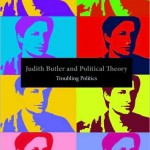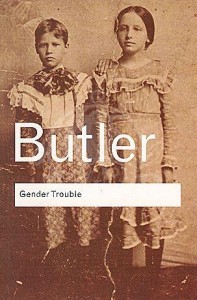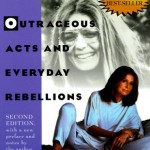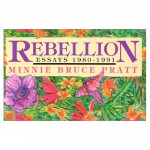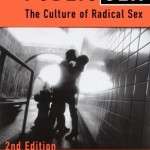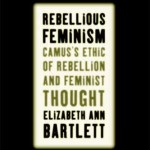A couple of days ago I queried: Is trouble an adjective, a verb, a noun, or what? I came to the conclusion that all three of the ways in which to understand trouble (as describing a state; as an action; as a form of ethics/politics) were important. Today, as I was organizing my office (yes, I am still cleaning!), I came across a great article that I used last time I taught Queering Theory: Janet Jakobsen’s “Queer is? Queer Does? Normativity and the Problem of Resistance.” As “luck” would have it, the article was open to page 317–the page on which I have written in all caps: VERB NOUN ADJECTIVE. Sound familiar?
Jakobsen is discussing the nature of the term “queer”–is it just something you are, a queer (noun)? Or, is it something you do, engaging in resistance to norms and normalizations (verb)? Or is it something that describes who you are (adjective)? She concludes that queer is all three and that in order for us to fully engage with the term and to understand how it functions in specific and concrete practices we must consider how these three (noun, verb, adjective) are connected and how they work with and against each other.
One of Jakobsen’s primary concerns is that while we invoke “queer” as something that we should do (verb), we rarely interrogate how we should actually do it. Jakobsen argues that “queer” becomes the ending, and the last word, on critiques of lesbian/gay or feminist politics. “We stick with invocation,” she argues, “because we don’t fully know how to talk or write differently, to produce something other than an ending” (512). But, what would it look like to think through what it means (and how it feels) to do queer, or, as Jakobsen puts it, to make queer the starting point of our thinking and writing instead of the ending?
In “Queer is? Queer Does?” Jakobsen uses queer as the starting point for a “thinking through of the complications of embodiment, of resistance, of norms, and of the associated terms of normativity and the normal” (512). She asks: What is a norm and how does it differ from (hetero/homo) normativity or being normal? What ethical/political possibilities open for our understanding of how we can and do resistance (that is, have political and moral agency) when we think beyond queer doing as resisting the Norm? What happens when we start to unpack normal/normativity’s “matrix of multiple, contradictory norms” (513)?
Is any of this making sense? I have to admit that I have struggled with writing this entry for several days. It has gone through several permutations (including linking Jakobsen’s argument with Nikki Sullivan’s chapter, “Queer: A Question of Being or Doing?” and the complicated history of identity politics. Thankfully, I thought better about opening up that whole can of worms. It is July, after all. If I started writing about identity politics, I would still be writing this entry in October!). So, why is this article so troublesome? Why am I having difficulty writing about it? The last time I taught Queering Theory, I assigned it. We discussed it a little, but I remember thinking that we didn’t really get at the complexity of Jakobsen’s argument. Why?
I really like Jakobsen’s argument. The idea of thinking through how we actually queer (as a doing, as resistance) is very important. And her disentangling of “norms,” “normal” and “normativity” is crucial for developing a queer ethics. But, this article is long and complicated and takes on a lot. Her argument seems to require significant background knowledge of poststructural conversations about the” tension between the radical critique of subjectivity” and “the political project of undertaking resistance” (514). And, if that weren’t enough, she continues on by connecting her discussion with Barbara Streisand, her “queer nose,” and the intersections between being/doing queer and jewishness. Wow!
I will read this article again (and again and, perhaps, again). And I will try to figure out how to use it for my queering theory class. Maybe I should just use a part of it? Hmmm…
One last thing: As I was reading through Gloria Anzaldua’s “To(o) Queer the Writer–Loca, escritora y chicana,” I came across this related passage:
Oblivious to privilege and wrapped in arrogance, most writers from the dominant culture never specify their identity; I seldom hear them say, I am a white writer. If the writer is middle class, white and heterosexual s/he is crowned with the “writer” hat–no mitigating adjectives in front of it. They consider me a a Chicana writer, or a lesbian Chicana writer. Adjectives are a way of constraining and controlling. ‘The more adjectives you have the tighter the box.’ The adjective before a writer marks, for us, the “inferior” writer, that is, the writer who doesn’t write like them. Marking is always “marking down” (250-251).
This pasage is helpful for thinking about the implications of using and not using adjectives. Is discussing queer in terms of its role as a noun, adjective and/or verb, useful for thinking through what queer (and maybe trouble too?) is?

